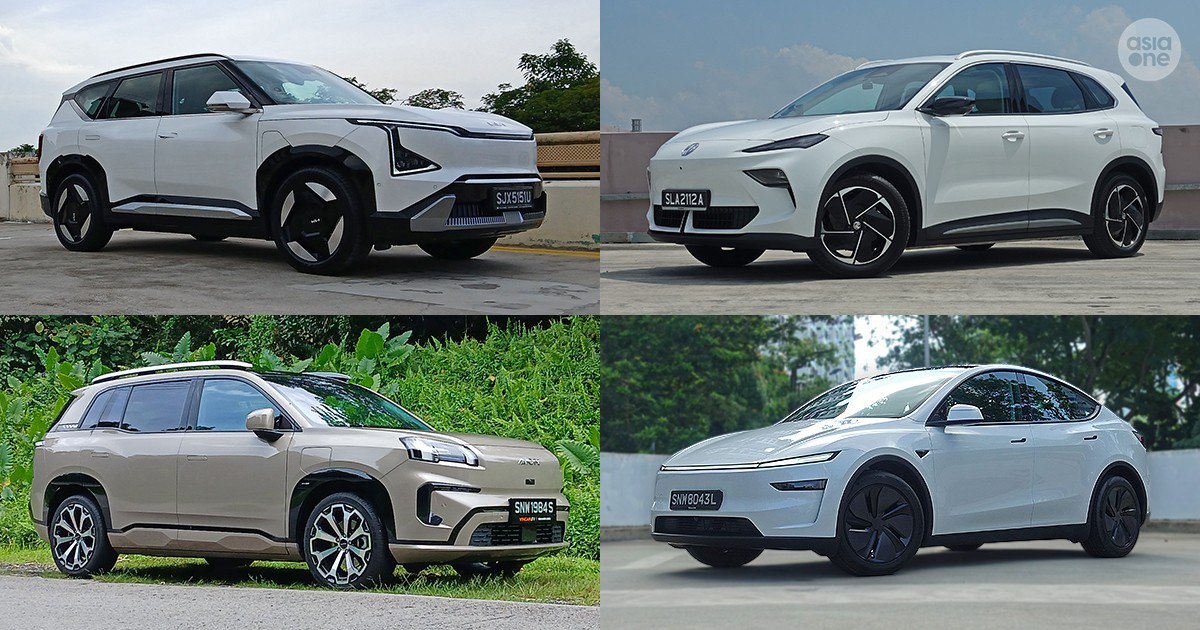Blog
8 Cat A EVs in Singapore to consider before the revised rebates for EVs kick in next year, Lifestyle News

Lifestyle
From Jan 1, cars falling under the current Band A1 of the Vehicular Emissions Scheme (VES), which are mostly EVs, will see their rebate reduced from $25,000 to $22,500.
In addition, the Electric Vehicle Early Adoption Initiative (EEAI) will also be revised. The initiative currently offers a rebate of up to 45 per cent off the Additional Registration Fee (ARF) from an EV, capped at a maximum of $15,000. This cap will be reduced to a maximum of $7,500 from Jan 1 onwards as well.
In sum, this means that the total amount of rebates that EVs can enjoy will effectively be reduced from a maximum of $45,000 currently to $30,000 come next year.
Mainstream car buyers would probably be looking for an EV that qualifies for a Category A COE, which dictates that EVs should have a maximum power output of 110kW/147hp.
[[nid:722371]]
The relatively lower premiums in Cat A means that the prices are somewhat more accessible, and it’s therefore no surprise that many mainstream EVs can be had with a Cat A COE.
There is no shortage of choices if one is shopping for an EV in Cat A. Many of them are SUVs, reflecting their general popularity among the car buying masses, but there is also sedan, MPV and hatchback options as well.
Lifestyle Kia EV5

What is it? The EV5 is Kia’s first locally-assembled model, for those who want an SUV with a Singaporean twist.
Why is it worth considering? There are plenty of electric SUVs on the market, but not many can boast of a Made in Singapore label.
The Kia EV5 is one of just three locally-built cars you can buy here, alongside the Hyundai Ioniq 5 and Ioniq 6, all of which are assembled at the Hyundai Motor Group Innovation Centre Singapore (HMGICS) at Jurong.
The Cat A-eligible EV5 is available in two variants, Air and Earth, both producing 130hp and 314Nm, but with different battery sizes:
Kia EV5 Air
– Battery size: 62.4kWh
– Range: 400km
Kia EV5 Earth
– Battery size: 88.1kWh
– Range: 540km
The Earth also adds extra equipment over the Air, such as a handy pullout compartment that can serve as a cooler or warmer, and Kia’s Remote Smart Parking Assist, a driverless feature that gets the car in or out of a parking lot using just the remote key.
There’s plenty of legroom for rear passengers, thanks to the EV5’s generous 2,750mm wheelbase, while the boot also includes a handy foldaway parcel shelf that can serve as a mini table of sorts.

Pricing starts at $214,000 with COE (as of October 2025) for the EV5 Air, although if you want all the goodies from the EV5 Earth as tested here, that’s going to cost $230,600 with COE, which is a bit pricey for a Cat A electric SUV.
Still, the EV5 does make for a fine choice with its all-round practicality and impressive list of features. The Made in Singapore label goes further to instil a sense of local pride too.
Also consider: Hyundai Ioniq 5, Hyundai Ioniq 6
Lifestyle MG S5

What is it? The MG S5 aims to challenge the market leader, the BYD Atto 3, with its combination of space, practicality and value.
Why is it worth considering? The BYD Atto 3 is the undisputed number one in the Cat A electric SUV segment, but MG is looking to snatch away the leadership crown with its S5 SUV.
Just one variant of the S5 is available, the Luxury trim, with 133hp and 250Nm of torque:
MG S5 Luxury
– Battery size: 62kWh
– Range: 425km
At first glance, the S5 looks to have all the ingredients to succeed. The design is pleasant but unassuming, and generally inoffensive to most.
The interior too is fairly simple and minimalist, like most EVs these days, with the dashboard being dominated by the 12.8-inch infotainment screen.
However, the software for the infotainment system is somewhat laggy and inaccurate in operation, which can make it frustrating to use on the move.
Where it surprises though is the presence of physical buttons and switches for the climate control system, a welcome sight in a world where everyone else is moving towards a touchscreen-heavy interface.

Like many of its electric SUV rivals, the S5 offers extremely generous room for rear passengers, thanks to its 2,730mm long wheelbase.
Boot space is decent too, with 423 litres of capacity available, expandable to 1,423 litres with the seats folded down.
The S5’s price tag of $201,888 with COE (as of October 2025) is only a $5,000 difference over the Atto 3, and on this evidence, it certainly makes a strong case for those who want a fuss-free electric Cat A SUV but don’t want to drive what everyone else is having.
Also consider: Byd Atto 3, Hyundai Kona Electric
Lifestyle Aion v

What is it? Aion’s V electric SUV delivers great value by offering premium features at a reasonable price.
Why is it worth considering? The Chinese car brands are fighting over themselves to see who can deliver the best value to customers, but Aion looks like it has an upper hand with its V electric SUV.
Two variants of the Aion V are available, the Premium and Luxury, both with 134hp and 240Nm of torque, but with different battery sizes:
Aion V Premium
– Battery size: 64.5kWh
– Range: 435km
Aion V Luxury
– Battery size: 75.3kWh
– Range: 485km
The Luxury also adds on lots of extra features such as a folding table behind the front seats, massage seats for the front occupants, and even an integrated fridge/heater, which is extremely useful for storing drinks, ice cream or takeaway food on the way home.
Like many of the electric SUV offerings in Cat A, the V looks fairly nondescript, although it does try to stand out with its slightly rugged, chunky and square design.
The styling does well to mask the car’s size too, for the V is actually slightly larger than most of its direct competitors in terms of dimensions.
The car measures 4,605mm long, 1,854mm wide and 1,686mm tall, which makes the V quite a fair bit bigger than the likes of the BYD Atto 3 and Omoda E5.
The resulting 2,775mm wheelbase means that you get an immense amount of legroom at the back.
But it’s not just space that passengers can enjoy. The rear seats come with adjustable backrests that allows you to recline, which is a feature nearly unheard of in this segment and price point.

As well-equipped as the V is, it does suffer from the typical Chinese EV drawback of an overly minimalist interior, with every function accessible only via the 14.6-inch infotainment touchscreen, and a lack of physical button controls throughout.
Where the Aion V excels is in refinement, with the suspension soaking up bumps extremely well, and delivering a ride that’s soothing and comforting on almost all road surfaces.
The entry-level Aion V Premium starts at $191,888 with COE (as of October 2025), while the Aion V Luxury featured here is going for $198,888 with COE.
The fact that the Aion V manages to undercut many of its rivals’ pricing while still offering a lot more features makes it an extremely compelling value proposition for those looking for a Cat A EV that offers a premium experience.
Also consider: Omoda E5, Jaecoo J6 RWD
Lifestyle Tesla Model Y 110

What is it? Tesla’s hugely popular Model Y gets a Cat A variant specifically for Singapore
Why is it worth considering? Tesla doesn’t do major updates very often, so when it does, it is certainly a very big deal.
The facelifted Model Y was introduced here earlier in 2025, and aside from the heavily refreshed styling, the most significant change was the addition of a new variant that’s eligible for a Cat A COE.
The Cat A version with 147hp is based on the regular Model Y RWD, and they share the same battery size and 350Nm of torque:
Tesla Model Y 110
– Battery size: 62.5kWh
– Range: 466km
The thing with artificially turning down the power is that the performance can feel restrained. While the Model Y 110 won’t blaze any trails, it manages to cope reasonably well with everyday driving in Singapore.
The car rides quietly and mostly smoothly, but the suspension can get busy over harsher bumps. The steering too, while accurate, is somewhat devoid of feel, and it doesn’t come across like a car that you would particularly enjoy driving down a winding road.
Outside of the driving bits, the Model Y’s most significant changes pertain to its looks. The slim light bar that stretches horizontally across the front is meant to mimic the Cybertruck, while the similar-style rear lights are reflected on a panel that feature the Tesla name.

In contrast, the changes to the interior are relatively minor in nature. The most significant one is the return of a physical stalk for the indicators, instead of steering wheel buttons previously.
Other additions include a new 8.0-inch rear touchscreen that allows backseat passengers to control the audio and air con, as well as play games and watch videos.
The rear seats can also be folded down electrically at the touch of a button, and doing so expands the boot space from an already-massive 854 litres to a colossal 2,138 litres.
All of that only serves to boost the Model Y’s appeal even further, but crucially, the addition of a Cat A-eligible version means that the Model Y is now available at a more accessible price.
As of October 2025, the Model Y 110 is retailing for $211,365 with COE. It’s not that far off from some of the smaller Chinese Cat A EVs, but with the Tesla, you definitely get a lot more car for your money.
Also consider: BYD Sealion 7 Dynamic, Tesla Model 3 110
Lifestyle Volvo Ex30 110kw

What is it? Volvo attempts to join the Cat A EV game with a 110kW version of its EX30 small SUV
Why is it worth considering? The Volvo EX30 is one of a trio of small EVs that sit on the Geely Group’s Sustainable Experience Architecture 2 (SEA 2) platform, with the other two being the Zeekr X and the Smart #1.
All three were launched in Singapore last year, but the Volvo is the first to offer a Cat A version. Zeekr have since followed suit recently, but there is still no word on whether there will be a Cat A version of the Smart in the pipeline.
Power h as been reduced to 147hp, but torque remains unchanged at 343Nm, and there are two variants with different battery sizes:
Volvo EX30 Plus
– Battery size: 51kWh
– Range: 337km
Volvo EX30 Ultra
– Battery size: 69kWh
– Range: 475km
The EX30 is still pretty sprightly on its feet under acceleration, and you only sense the lack of grunt once you get up to higher speeds and the car starts to run out of puff. But in everyday driving conditions, there seems to be virtually no difference between this car and its more powerful sibling.
Everything else is pretty much the same otherwise too. The EX30’s compact dimensions means that it is easy to drive, manoeuvre and park. It also takes on corners reasonably well, with plenty of composure.
Likewise, the ride can best be described as competent, if not quite excellent. The suspension does get busy over badly surfaced roads, and the car can get a bit unsettled as a result, although it probably won’t be dealbreaker for most.

The EX30’s biggest weakness would be its interior. The portrait-orientation 12.3-inch touchscreen is where all the controls and vital information are located, and it can prove distracting when you want to do things like check the speed or adjust the mirrors.
The centrally-located glovebox (opened via the touchscreen of course) and cupholders that slide out through the centre armrest seem clever. But actual room for humans is sub-par, with space being rather tight for rear passengers, and legroom especially lacking.
Pricing starts at $236,000 with COE (as of October 2025) for the EX30 Plus. The EX30 Ultra tested here adds on extras like a panoramic sunroof and a 360-degree camera, but its price tag of $250,000 with COE is perhaps a bit on the higher end.
Considering what you’re getting though, it’s not entirely unexpected for a premium brand like Volvo.
Also consider: Zeek XDD RWD, Mini, Miniman E
Lifestyle World m6

What is it? BYD’s M6 MPV is a budget people carrier for those who want something affordable to drive their family around.
Why is it worth considering? There aren’t many Cat A EVs that can offer seating for seven. Indeed, aside from the BYD M6, the only other seven-seater electric option with a Cat A COE is the Maxus Mifa 7, which is a far larger MPV with a correspondingly bigger price tag.
If you want a fuss-free, no-frills electric MPV, then the BYD M6 is the answer. It’s a car that’s as basic as they come, being based on dated mechanicals, and designed to serve a singular function as a family runabout.
The M6 comes with just one powertrain, with 134hp and 250Nm of torque:
World m6
– Battery size: 71.8kWh
– Range: 440km
The car rides reasonably well, with a smooth and composed suspension setup that evens out most bumps decently, but it’s definitely not something that excites the senses.
As an MPV, the M6 fares just about alright. The car’s 4,710mm length is a decent size, and the second-row passengers do enjoy plenty of legroom. Those in the third row though will find it a bit of a squeeze, but it’s not unduly uncomfortable.

Despite its back-to-basics nature, the M6 comes fairly decently equipped. Standard features include a panoramic sunroof, a wireless smartphone charger, and driver assistance systems like automatic emergency braking and adaptive cruise control.
For its asking price of $201,888 with COE (as of October 2025), the BYD M6 represents excellent value, especially if you really want an EV that can accommodate seven. It’s not going to set your pulse racing, but it will serve its intended purpose well.
Also consider: Maxus Mifa 7 108kW, Aion Y Plus
Lifestyle CITIES E-C4X

What is it? The Citroen e-C4X is a French electric sedan with a difference, offering off-beat looks with decent practicality.
Why is it worth considering? There are electric sedans, and there are electric SUVs, but the Citroen e-C4X appears to be a car that is trying to be both at the same time.
The body style of the e-C4X is obviously that of a sedan, but the raised ride height is the hallmark of an SUV. You could call it a crossover if you like, but most people will probably call it odd.
That strangeness extends to the interior too. The driver instrument display is weirdly tiny, and there is a pull-out drawer above the glovebox, along with what looks like a tablet holder.

Once you get past the weirdness, you’ll find that the e-C4X is a rather practical car. There’s enough legroom for rear passengers, although headroom is a bit tight, and the Shine Plus variant tested here comes with a 360-degree camera and massaging seats for both front occupants.
The Shine Plus is currently the sole variant of the e-C4X available, with 134hp and 270Nm of torque:
Citroen e-C4X Shine Plus
– Battery size: 54kWh
– Range: 436km
Power delivery comes along smoothly and linearly, instead of in a sudden burst like many other EVs. This makes for a rather relaxing driving experience if you’re not in a hurry.
Citroen is famed for its soft and pillowy ride quality, and the e-C4X is no exception. The car goes over bumps with hardly any fuss, but the trade off is a handling setup that’s rather dull and uninspiring.
Still, the e-C4X is an electric sedan that offers plenty of character, albeit not one that appeals to everyone. Its price tag of $185,999 with COE (as of October 2025) is rather attractive too in this current climate, although it certainly faces tough competition from a handful of other Chinese electric sedans in the market.
Also consider: JMEV Elight, BYD Seal 6
Lifestyle Ora Good Cat

What is it? The Ora Good Cat is a cutesy little electric hatchback with plenty of charming appeal.
Why is it worth considering? For the youthful driver who doesn’t need an SUV or sedan to ferry family members, a small hatchback would probably be the right size of car to zip around our city in.
Few are as charming and characterful as the Ora Good Cat however.
The name itself is enough to turn plenty of heads, and its curvy styling certainly helps to push the cute feline theme even further. You could just about imagine the headlights being the eyes, and the Ora logo being the nose, while the lower bumper represents the cat’s smiley face.

The interior, in contrast, looks a little bit more traditional. The 10.25-inch infotainment screen and 10.25-inch driver instrument display combine to look like one giant screen, and while it is still a touchscreen-intensive interface, there are still some physical switches present to control some of the air con’s functions.
For a small hatchback, the Good Cat offers a surprisingly good amount of space for rear passengers. Boot space however is a rather limited 228 litres in capacity, although that is really to be expected for a car of its size.
There’s only one powertrain option for the Good Cat here, with 141hp and 210Nm of torque:
Ora Good Cat
– Battery size: 63kWh
– Range: 420km
While it’s certainly no cheetah, it is capable of some rather sprightly performance, building up speed briskly with minimal fuss.
It also has a fairly composed ride, and its handling is generally safe and docile, which is pretty much standard cat-like behaviour.
For its price tag of $191,999 with COE (as of October 2025), you get a car that boasts plenty of charming appeal. There are certainly other electric hatchbacks on the market that can arguably offer greater value, but few can match the delightful character of the Ora Good Cat.
Also consider: Dongfeng Box, BYD Dolphin
[[nid:722532]]
No part of this article can be reproduced without permission from AsiaOne.



















